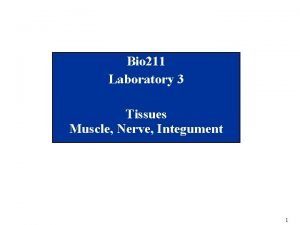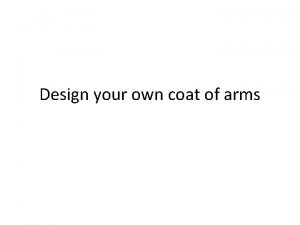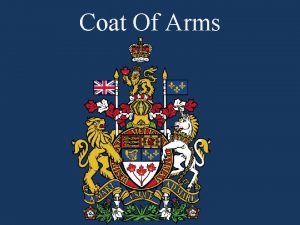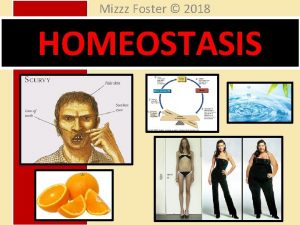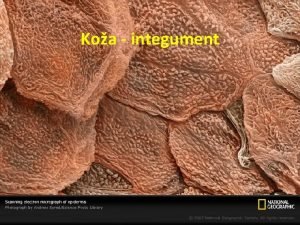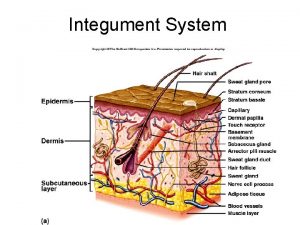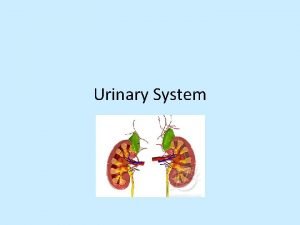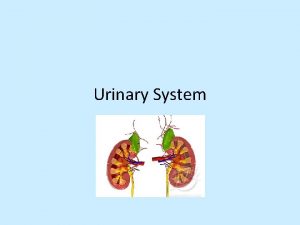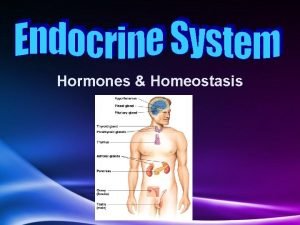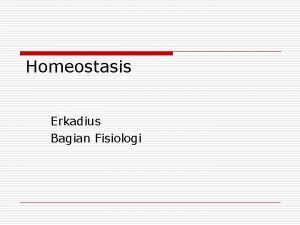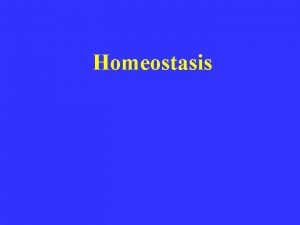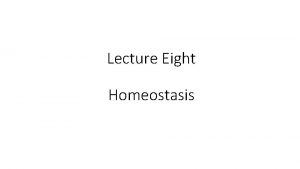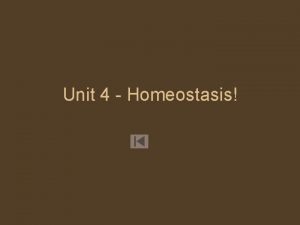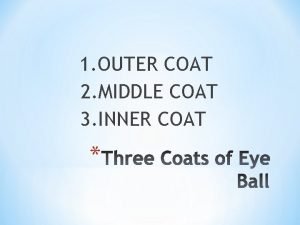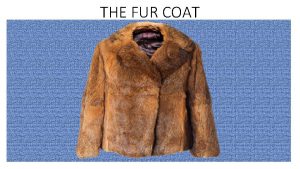THE INTEGUMENT YOUR WATERPROOF COAT FUNCTIONS Maintains homeostasis







































- Slides: 39

THE INTEGUMENT YOUR WATERPROOF COAT

FUNCTIONS • Maintains homeostasis • Protection (keratinization) • Synthesis of chemicals and hormones • Excretion of water, wastes, salts • Absorption of fat soluble vitamins (A, D, E, K) • Sense organ • Production of melanin

STRUCTURE • 2 LAYERS: – EPIDERMIS – OUTER, THINNER LAYER (. 1 mm); keratinized, stratified squamous epithelial tissue – DERMIS – inner thicker layer; connective tissue – DERMAL/EPIDERMAL JUNCTION (basement membrane)

STRUCTURE • Beneath the dermis, loose, subcutaneous layer rich in adipose and areolar tissue – HYPODERMIS or SUPERFICIAL FASCIA


EPIDERMIS • 4 types of cells: – Keratinocytes – 90% of all epidermal cells, arranged in layers – Melanocytes – 5% - skin color and UV light filter – Langerhans – immunity – Merkel - sensory

LAYERS OF EPIDERMIS 1. Stratum basale – single layer of columnar cells – mitosis here 2. Stratum spinosum – 8 – 10 layers of irregularly shaped cells with prominent desmosomes – cells rich in RNA to make keratin 3. Stratum granulosum – 2 – 4 layers deep – filled with keratohyalin granules

LAYERS OF EPIDERMIS 4. Stratum lucidum – clear – only in thick skin – cells filled with eleiden that becomes keratin 5. Stratum corneum – horny layer – 25 – 30 rows of dead cells – cytoplasm of cells filled with keratin – membranes thick






DERMIS • AKA = corium – 2 layers 1. Papillary – areolar - fine collagenous and elastic fibers – dermal papillae 2. Reticular – dense, interlacing collagen and elastin – dense irregular connective tissue

DERMIS • “True” skin; strength, reservoir storage area for water, electrolytes, specialized sensory receptors. Muscle fibers, hair follicles, sweat and sebaceous glands, bvs • At each hair follicle, arrector pili muscles

SURFACE MARKINGS • Dense fibers of white collagenous fibers in reticular layer of dermis oriented in patterns – LANGER’S LINES (cleavage lines) • Thin epidermis conforms tightly to dermal papillae – gives characteristic ridges



SKIN COLOR • Melanocytes • Tyrosine -> melanin (tyrosinase is the enzyme!!) • With age, decreasing tyrosinase • THE DREADED GRAY HAIR


SKIN COLOR • Carotene (yellowish pigment) also adds to skin color • BVs dilate, blush • BVs constrict, pale • Pigmentation?

APPENDAGES OF THE SKIN 1. HAIR 2. NAILS 3. GLANDS

1. HAIR • • • COVERS MOST OF BODY… EYELASHES, NOSE AND EAR HAIR LANUGO TERMINAL HAIR OF EPIDERMAL ORIGIN HAIR PAPILLA PROTRUDES INTO BOTOM OF FOLLICLE (GERMINAL MATRIX)

1. HAIR (cont’d) • As cells of germinal matrix divide and move up, become keratinized • Shaft – visible part • Medulla – inner core • Cortex – outer core • Each follicle -> 2 or more sebaceous glands (sebum) • Growth ~ 1/2 “/ month




2. NAILS • • Heavily keratinized epidermal cells Nail body = visible part Root hidden by cuticle Nail body nearest root = LUNULA


3. GLANDS A. Sweat ( sudoriferous) 1. Eccrine • most numerous • produce sweat (water, salt, ammonia, urea and uric acid) • eliminate waste 2. Apocrine • Deep in subcutaneous layer in armpit, areola, + pigmented perianal areas

3. GLANDS B. • • • C. • • • SEBACEOUS Oil or sebum Everywhere but palms and soles Lipids have antifungal acivity CERUMINOUS Modified apocrine sweat glands Secret cerumin Protects ear canal from dehydration

SURFACE FILM

HOMEOSTASIS • Set point = 37 o. C • Heat loss by radiation, evaporation, conduction, convection • 80% through skin • Rest is respiratory, urinary, digestive

OTHER STUFF… • • • BURNS SKIN CANCER AGING FINGERPRINTS VERNIX CASEOSA

BURNS • • • 1 o 2 o 3 o First 24 hours, dehydration After 24 hours, infection



SKIN CANCER • Basal cell carcinoma • Squamous cell carcinoma • Malignant melanoma

 How the respiratory system maintains homeostasis
How the respiratory system maintains homeostasis Bioflix activity homeostasis hormones and homeostasis
Bioflix activity homeostasis hormones and homeostasis Bioflix activity homeostasis high blood glucose
Bioflix activity homeostasis high blood glucose Organum germinativum
Organum germinativum Integument
Integument Integument
Integument Exfoliative dermatitis
Exfoliative dermatitis Duct of merocrine sweat gland
Duct of merocrine sweat gland Asam riaz
Asam riaz Integument
Integument Maslow's theory maintains that________.
Maslow's theory maintains that________. Integrative social contracts theory maintains that
Integrative social contracts theory maintains that In each node maintains a vector (table)
In each node maintains a vector (table) Who maintains the north american cargo securement standard
Who maintains the north american cargo securement standard Maslow's theory maintains that
Maslow's theory maintains that Example of universal principles
Example of universal principles Xschool cgw
Xschool cgw In scrum, the ____ maintains the product backlog list.
In scrum, the ____ maintains the product backlog list. Design my own coat
Design my own coat Chanson sur les vêtements en anglais
Chanson sur les vêtements en anglais There fifteen candies in that bag. now there only one left
There fifteen candies in that bag. now there only one left It's warm inside your coat
It's warm inside your coat Give us your hungry your tired your poor
Give us your hungry your tired your poor Hình ảnh bộ gõ cơ thể búng tay
Hình ảnh bộ gõ cơ thể búng tay Bổ thể
Bổ thể Tỉ lệ cơ thể trẻ em
Tỉ lệ cơ thể trẻ em Gấu đi như thế nào
Gấu đi như thế nào Tư thế worms-breton
Tư thế worms-breton Hát lên người ơi alleluia
Hát lên người ơi alleluia Môn thể thao bắt đầu bằng chữ f
Môn thể thao bắt đầu bằng chữ f Thế nào là hệ số cao nhất
Thế nào là hệ số cao nhất Các châu lục và đại dương trên thế giới
Các châu lục và đại dương trên thế giới Công thức tiính động năng
Công thức tiính động năng Trời xanh đây là của chúng ta thể thơ
Trời xanh đây là của chúng ta thể thơ Cách giải mật thư tọa độ
Cách giải mật thư tọa độ 101012 bằng
101012 bằng độ dài liên kết
độ dài liên kết Các châu lục và đại dương trên thế giới
Các châu lục và đại dương trên thế giới Thơ thất ngôn tứ tuyệt đường luật
Thơ thất ngôn tứ tuyệt đường luật









